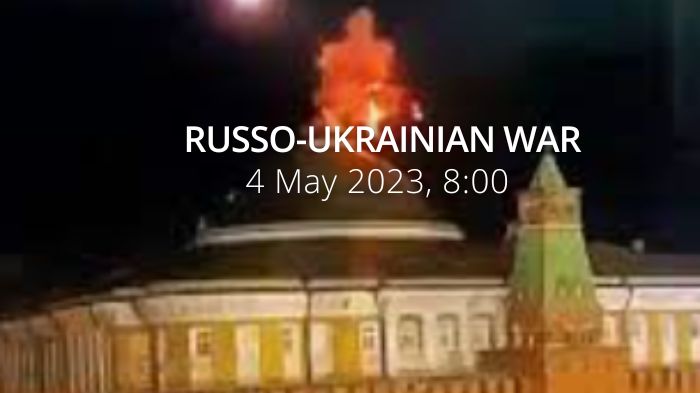Russia fires almost 40 missiles on Mykolaiv. The Kremlin has not responded to the Red Cross's request to access the Olenivka prison. Russians conducted limited ground attacks southwest and northwest of Izium. Russian forces continued ground attacks northwest of Sloviansk, northeast of Siversk, and to the east and south of Bakhmut. Russian occupation authorities continued to prepare for a referendum in Kherson Oblast. Ukrainians destroy 15 Russian ammo depots over the past weeks. Russia’s special train of over 40 cars destroyed with HIMARS in the Kherson Oblast. Russian forces build up grouping in Kryvyi Rih direction. Russia fired at least 20 missiles into northern Ukraine from Belarusian territory. Norway donates armored patrol vehicles to Ukraine. Putin says the United States is the main threat to Russia.
Daily overview — Summary report, July 30
A map of the approximate situation on the ground in Ukraine as of 00:00 UTC 01/08/22.
There have been no notable changes to control since the last update. pic.twitter.com/700uoVO934
— War Mapper (@War_Mapper) August 1, 2022
According to military expert Stanislav Haider, as of July 30,
Russian assaults failed in the areas of Kamianka and Pisky. Pokrovske, Vershyna are under Ukrainian control. The situation in the direction of Bakhmut is difficult, but the Ukrainian Armed Forces keep holding the front line Travneve-Kodema-Zaitseve.
In the south of Donetsk Oblast, Ukrainian troops are defending recaptured Russian positions. The withdrawal of Russian units and transferring them to the south continues, in particular from Sloviansk to Zaporizhzhia direction.
Russian troops have not yet completely captured Luhansk Oblast as two settlements remain under Ukrainian control.
Kharkiv Oblast. No changes at the border. There was an unsuccessful Russian assault in the direction of Husarivka. In the direction of Izium, the Russians tried to regain lost positions, unsuccessfully. Yet another reconnaissance group was neutralized in the direction of Yakovlivka.
Kherson Oblast. Russia continues to concentrate forces in the Kherson direction, mainly using the repaired bridge at the Kakhovskaya Hydroelectric Power Plant. Meanwhile, the Armed Forces of Ukraine successfully repel counterattacks in the Inhulets area and hold the areas recaptured from the occupiers. The Ukrainian artillery is also working well - a telling example is the destruction of a train with Russian troops, equipment, and ammunition that was traveling from occupied Crimea towards the front.
Zaporizhzhia Oblast. Battles continue in the Shcherbaky, Nesterianka, Dorozhnianka, and Inzhenerne areas where Ukraine repulsed all Russian attacks. Ukrainian troops achieved minor successes in the Polohy area and continued their advance.
The work of the Ukrainian artillery:
- Russian ammunition warehouses: Skadovsk (Kherson Oblast), Vasylivka area, Tokmak (Zaporizhzhia oblast), Donetsk;
- a Russian base: Melitopol (Zaporizhzhia oblast);
- both ammo depot and a base: Beryslav area (Kherson Oblast).
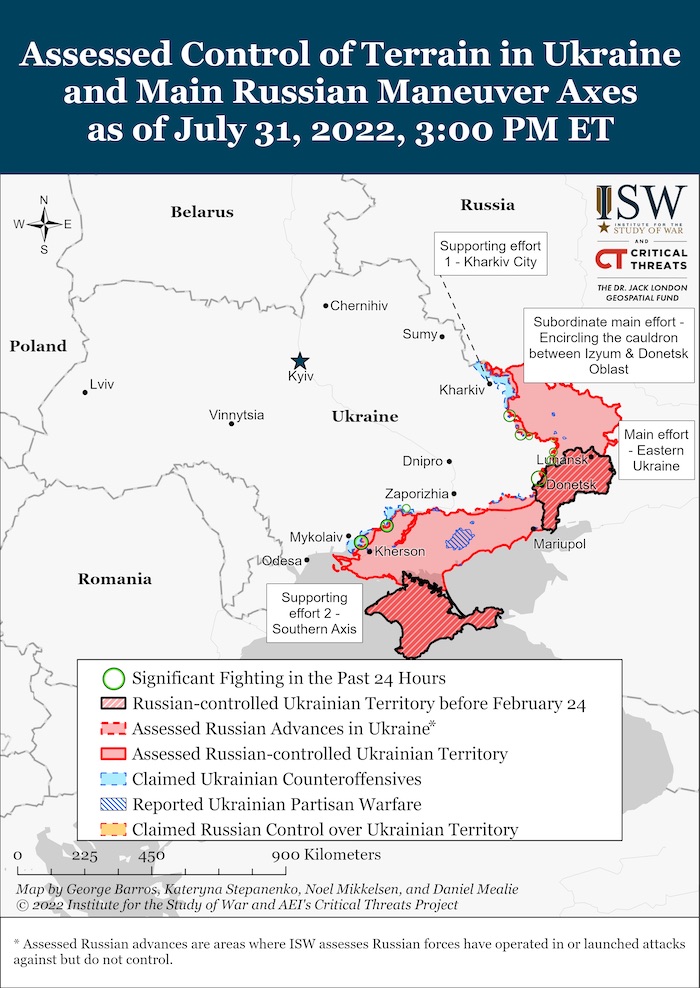
The General Staff’s operational update regarding the Russian invasion as of 06.00 am, July 30, 2022 is in the dropdown menu below.
“[The situation has not changed in the Volyn and Polissya directions, units of the Armed Forces of the Republic of Belarus are carrying out the task of strengthening the protection of the section of the Belarusian-Ukrainian border in the Brest and Gomel regions.] The additional deployment of radio-electronic warfare complexes by the armed forces of the Republic of Belarus is noted in the border areas.
In the Siversky direction, Russian forces continue to hold separate units of the armed forces of the Russian Federation in the border areas of the Bryansk and Kursk regions. Conducted artillery fire near Pavlivka, Sumy oblast. [Yesterday, Russian forces shelled the areas of the settlements of Hai and Senkivka in Chernihiv oblast and Shevchenko, Ryzhivka, Bilopillia, Iskryskivshchyna and Romashkove in Sumy oblast with artillery and MLRS. it also conducted an aerial reconnaissance of the UAV near the Zaliznyy Mist in Chernihiv oblast.]
[In the Slobozhansky direction:]
- In the Kharkiv direction, Russian forces shelled the areas of settlements Novomykolaivka, Prudyanka, Nove, Dementiivka, Pytomnyk, Borshcheva, Ruska Lozova, Ruski Tyshki, Petrivka, Bazaliivka, Korobochkine, Stara Hnylytsia, Ivanivka from tanks, artillery and MLRS. Made an air strike near Mospanove. [Yesterday, Russian forces carried out fire damage from artillery and MLRS in the areas of the settlements of Kharkiv, Duvanka, Udy, Dementiivka, Petrivka, Prudyanka, Pytomnyk, Pryshyb, Pushkarne, Ruski Tyshky, Protopopivka, Verkhnya Rohanka, Korobochkyne, Borschova, Stary Saltiv, Ruska Lozova, Slatyne and Sosnivka. Made an airstrike near Stary Saltiv. The occupiers unsuccessfully tried to advance in the direction of Husarivka. They were repulsed and left.]
- In the Sloviansk direction, Russian forces carried out fire damage near Chepil, Protopopivka, Hrushuvaha, Husarivka, Dibrovne, Mazanivka, Krasnopilla, Dolyna and Barvinkove. A reconnaissance group tried to clarify the location of the positions of our troops in the direction of Mazanivka, but was unsuccessful, the group withdrew. [Yesterday, Russian forces used artillery to shell the areas of the settlements of Sloviansk, Andriyivka, Dolyna, Dovhenke, Kurulka, Husarivka, Adamivka, Bohorodychne, Krasnopillya, Karnaukhivka, Chervone, Semilanne, Hrushuvaha, and Chervona Polyana.]
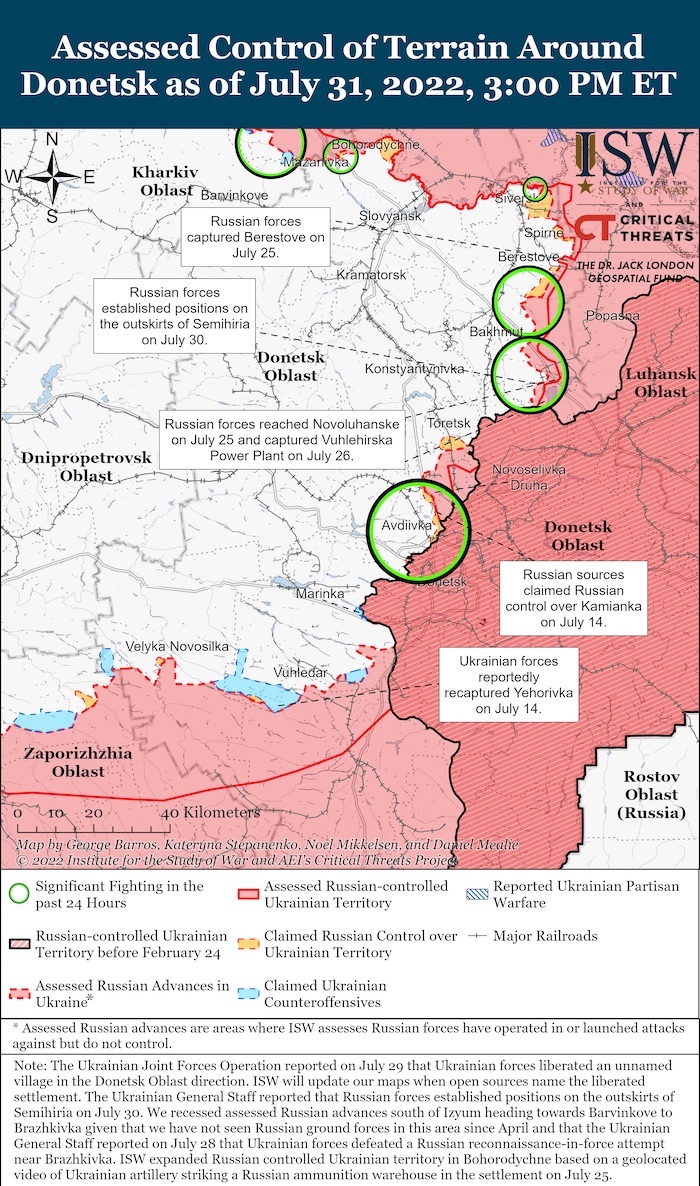
[In the Donetsk direction:]
- Russian forces were not active in the Kramatorsk direction. It carried out shelling from artillery, MLRS and tank weapons near Siversk, Serebryanka, Hryhorivka, Verkhnyokamyanskyi, Zvanivka, Ivano-Daryivka, and Spirne. Airstrikes near Hryhorivka and Spirny. [Yesterday, Russian forces fired from artillery, MLRS and tanks in the districts of Siversk, Kalenyky, Pereizne, Zvanivka, Viimka, Verkhnyokamyanske, Kryvya Luka, Spirne and Serebryanka. Airstrikes near Spirne and Hryhorivka.]
- [In the Serebryanka region, a reconnaissance group tried to identify the positions of our troops, but was unsuccessful and withdrew. Used for reconnaissance of UАVs near Hryhorivka.]
- In the Bakhmut direction, shelling was recorded near Berestove, Soledar, Bakhmut, Kostiantynivka, Vesela Dolyna, Zaitseve, Vershyna, Kodema, Semyhirya and Travneve Made an air strike near Kodema. [Yesterday, Russian forces shelled the areas of Kodema, Vershyna, Travneve, Bakhmut, Zaytseve, Soledar, Yakovlivka, Pokrovske and Bilohorivka settlements.]
- Tried to carry out reconnaissance of the positions of our troops in the direction of Yakovlivka. A Russian reconnaissance group was neutralized. Russian forces also tried to conduct assaults in the directions of Vershyna and Soledar, but were unsuccessful and retreated. Conducts an offensive in the direction of Bakhmut, hostilities continue. [Yesterday, under the cover of aviation, it tried to improve the tactical position in the areas of Vershyna, Soledar, Yakovlivka, and Pokrovske. Our soldiers thwarted these plans with accurate fire. After unsuccessful assaults, the occupiers retreated.]
- In the Avdiivka direction, the occupiers shelled the areas of the settlements of Novokalynove, Novoselivka, Avdiivka, Netaylove, Pisky, and Krasnohorivka. Airstrikes near Vesele. It assaults in the direction of Pisky, was unsuccessful, withdrew. [Yesterday, Russian forces, using available means of fire damage, fired near Nevelske, Umanske, New York, Krasnohorivka, Avdiivka, Pisky, and Novobakhmutivka. Russian attack and army aircraft cynically struck the settlements of Avdiivka, Novoselivka, and Yuryivka.]
- [Yesterday, the occupiers tried to advance in the districts of Kamianka and Pisky. Here the assault failed. In the Avdiivka region, individual units of Russian forces have partial success.]
- On the Novopavlivske and Zaporizhzhia directions, it is shelling the areas of Mariinka, Novomykhailivka, Pavlivka, Shevchenko, Novosilka, Novopil, Malynivka, Charivne, Hulyaipilske, Orihiv and Kamianske settlements with artillery and MLRS. Carried out airstrikes near Mariinka, Novomykhailivka, Vuhledar, Shcherbaky, Mali Shcherbaky and Novoandriivka. Conducted combat reconnaissance in the direction of Mariinka, had no success and withdrew. Enemy troops are regrouping in the Zaporizhzhia direction. [Yesteday, shelling was recorded in the areas of Mariinka, Prechystivka, Velyka Novosilka, Novopilla, Novosilka, Vremivka, Bilohirya, Zelene Pole, Pavlivka, Olhivske, Vuhledar, Novoukrainka, Temyrivka, Stepnohirsk, Hulyaipilske, Mala Tokmachka, Zaliznychne, Nesteryanka and Mali Shcherbaky. Attack and army aircraft of Russian forces struck near Maly Shcherbaky, Stepove, Mariinka and Yehorivka. Russian forces carried out aerial reconnaissance by UAVs near Stepnohirsk and Myrne.]
- [The movement of separate units of Russian forces from Sloviansk to Zaporizhzhia was recorded.]
[In the Pivdenny Buh direction, Russian forces were concentrating their efforts on holding the occupied lines and preventing the Defense Forces from creating favourable conditions for resuming the offensive. Uses available means of fire damage to attack the positions of our troops, destroy civilian and military infrastructure along the contact line and in the depth of the defense.] The occupiers shelled the districts of Myrolyubivka, Novovoznesenske, Visokopilla, Mykolaiv and more than 25 settlements with artillery, MLRS and tanks. Conducted an airstrike near Olhyne. Air reconnaissance of the UAVs continues.
- The strengthening of Russian forces in the Kryvyi Rih direction is noted.
- Active involvement of aviation by Russian forces to control the surface and air situation in the northwestern part of the Black Sea area is recorded.
[Russian maritime forces in the waters of the Black Sea and the Sea of Azov focus their main efforts on blocking civilian shipping in the northwestern part of the Black Sea and damaging military facilities and infrastructure elements deep in the territory of Ukraine.]
The threat of missile strikes on military facilities and critical infrastructure facilities on the territory of Ukraine remains. There are six Kalibr sea-based cruise missile carriers in the waters of the Black Sea.”
Military Updates
Ukrainian multiple rocket launcher at work
Ukrainian BM-21 Grad MLRS firing its full load of rockets targeting Russian positions. Location and date unknown.https://t.co/8SzPfFu3ID pic.twitter.com/dRlY98ptPA
— Euromaidan Press (@EuromaidanPress) July 31, 2022
Some 15 Russian ammo depots destroyed in [Southern] Ukraine over past weeks, Ukrinform reports, citing RFE/RL. "The use of these systems (S-300 - ed.) indicates that Russian forces has not enough munitions, as our fire damage to ammunition depots in the temporarily occupied territories was quite powerful in the past two to three weeks. About 15 warehouses have been destroyed in our operational zone alone," [Natalia Humeniuk, chief of the coordination press center of the South's security and defense forces, said].
Russia’s special train of over 40 cars destroyed with HIMARS in Kherson Region, Ukrinform reports. “On the night of July 30, 2022, a special train of more than 40 cars with Russian troops, military equipment and ammunition, which arrived from Crimea to Kherson Region’s Brylivka Station, was destroyed with the High Mobility Artillery Rocket System (HIMARS). Russian forces’s manpower losses were as follows: about 80 killed and 200 injured”.
Headquarters of the Black Sea Fleet fired on from Sevastopol – Russian occupiers, Ukrainska Pravda reports. “The governor of Sevastopol claimed that the headquarters of the fleet was attacked by a Ukrainian drone. "The drone attack on the headquarters of the Black Sea Fleet was carried out from Sevastopol; operative and investigative work is underway to find the guilty parties," Olga Kovitidi, [Russian "senator" from occupied Crimea, said]. As a result of the alleged attack, Russian occupiers are reporting 6 people injured, with the condition of two injured people being assessed moderate.”
“The press service of the General Staff and the Ukrainian Chief Intelligence Directorate told Ukrainian Pravda that they do not have information about the above-mentioned statements of the Russian occupiers.”
Romania defuses drifting mine off Black Sea coast, Reuters reports. “Romania's military carried out late on Sunday a controlled explosion of a naval mine that had drifted close to the country's Black Sea shore, the defence ministry said. Mines began floating in the Black Sea after Russia invaded Ukraine on Feb. 24, and Romanian, Bulgarian and Turkish military diving teams have been defusing those drifting in their waters.”
Russian forces building up grouping in Kryvyi Rih direction, Ukrinform
reports, citing Operational Command South. "Russian forces continues to conduct hostilities on defense lines, building up a grouping in the Kryvyi Rih region with the aim of preventing our forces from breaking through, the statement reads. The Armed Forces don’t rule out that the Russian occupiers will further set up offensive strike groups.”
Russian forces withdraw from two settlements in the Zaporizhzhia region – intelligence, Ukrinform reports, citing the press service of the Defence Intelligence of Ukraine (DIU). "After the Armed Forces of Ukraine struck the positions of the occupying forces near the villages of Verkhnii Tokmak and Chernihivka in the Zaporizhzhia region on the night of July 29, the Rashists took personnel and equipment to other positions. About 40 wounded were taken to the hospital in Polohy. Almost all units were withdrawn from Chernihivka. Currently, there are several roadblocks and no more than 100 military personnel near the settlement. The rest of the occupiers, together with their equipment, were sent to the cities of Tokmak and Berdiansk, the report said.”
According to British Defence Intelligence, (last 48 hours):
- Over the last four days, Russia has continued to attempt tactical assaults on the Bakhmut axis, northeast of Donetsk, only managing to make slow progress. As briefed by the Ukrainian authorities last week, Russia is likely reallocating a significant number of its forces from the northern Donbas sector to southern Ukraine.
- Russia is probably adjusting the operational design of its Donbas offensive after failing to make a decisive operational breakthrough under the plan it had been following since April. It has likely identified its Zaporizhzhia front as a vulnerable area in need of reinforcement.
- On 28 July 2022, Russia fired at least 20 missiles into northern Ukraine from Belarusian territory. This follows Russia’s use of Belarusian territory to launch the main thrusts of its failed attempt to take Kyiv in February.
- Belarusian President Aliaksandr Lukashenka continues to follow Moscow’s line on the Ukraine conflict, stating on 21 July that Ukraine must accept Russia’s demands for the war to stop.
- His regime has become ever more authoritarian, with the expansion of the death penalty for ‘preparing terrorist acts’. His increasing and baseless accusations of Western designs on Belarus and Ukraine likely indicate that he has become almost wholly dependent on Russia.
Losses of the Russian army
As of Monday 1 August, the approximate losses of weapons and military equipment of the Russian Armed Forces from the beginning of the war to the present day:
- Personnel – more than 41030 (+200),
- Tanks – 1768 (+5),
- Armoured combat vehicles – 4011 (+7),
- Artillery systems – 932 (+16),
- Multiple rocket launchers –MLRS - 259 (+0),
- Air defence means – 117 (+0),
- Aircraft - 223 (+0),
- Helicopters - 190 (+0),
- Automotive technology and fuel tanks – 2912 (+10),
- Vessels/boats - 15 (+0),
- UAV operational and tactical level – 736 (+1),
- Special equipment – 82 (+2),
- Mobile SRBM system – 4 (+0),
- Cruise missiles – 174 (+0)
Russian enemy suffered the greatest losses (of the last day) in the Donetsk and Kryvyi Rih directions.
Intelligence report: 200 Russian marines defied orders, and refused to redeploy in Ukraine, Ukrinform reports, citing Vadym Skibitskyi, a spokesperson for DIU. "Nearly 200 servicemen with the 810th brigade refused to return to southern Ukraine. This caused a major issue, which, according to our data, delayed the process of refitting and coordinating the battalion-tactical group this May. But despite this, the BTGr was formed, and it is now in the south of our country, running combat operations. But these battalion-tactical groups are now completely different from those that they had at the onset, said Skibitskyi.”
⚰️russia's combat losses in Ukraine as of August 1
▪ 41030 killed soldiers (+200)
▪ 4011 APV (+7)
▪ 1768 tanks (+5)
▪ 932 artillery systems (+16)
▪ 223 aircraft and 190 helicopters
▪ 15 boats and cutters#StopRussia #StandwithUkraine pic.twitter.com/mFuXapGf6D— VoxUkraine (@voxukraine) August 1, 2022
Humanitarian
Retired #Ukraine naval commander abducted by #Russian invaders and taken to #Russia occupied #Crimea ‘for trial’#LetMyPeopleGo #StandWithUkraine #StopRussia #Oleksiy_Kiselyov https://t.co/6P1QabmHjV pic.twitter.com/6wlOt2OpEp
— Halya Coynash (@halyapuff) July 31, 2022
Russians ban ICRC from visiting the place of death of Ukrainian POWs in Olenivka, Ukrinform reports. “Our request to access the POWs from Olenivka penal facility yesterday has not been granted. Granting ICRC access to POWs is an obligation of parties to conflict under the Geneva Conventions, the ICRC posted on Twitter.”
Massive shelling of Mykolaiv: Russia fired almost 40 missiles, Ukrinform reports, citing the head of the Mykolaiv Regional Council, Hanna Zamazieieva. “Russian forces fired about 40 rockets at Mykolaiv early on July 31. It was one of the largest attacks since the beginning of the Russian invasion of Ukraine. Several infrastructure facilities were damaged by the shelling, including a hotel, a sports center, two educational institutions and a service station. Residential buildings were also damaged.”
Zelensky announces mandatory evacuation of Ukraine's Donetsk region, Reuters reports. “Ukrainian President Volodymyr Zelensky said on Saturday his government was ordering the mandatory evacuation of people in the eastern Donetsk region, the scene of fierce fighting with Russia. In a late-night television address, Zelenskyy also said the hundreds of thousands of people still in combat zones in the larger Donbas region, which contains Donetsk as well as the neighbouring Luhansk region, needed to leave. […] Residents who left would be given compensation.
Separately, domestic Ukrainian media outlets quoted Deputy Prime Minister Iryna Vereshchuk as saying the evacuation needed to take place before winter begins since the region's natural gas supplies had been destroyed.”
The Head of the Zaporizhzhia Oblast Military Administration urges people to leave the combat zone, Ukrainska Pravda reports, citing Ukrinform. “The head of the Zaporizhzhia Oblast Military Administration, Oleksandr Starukh, called for residents of the region to leave the combat zone.”
Almost 400,000 Ukrainians have already left occupied territories through Zaporizhzhia, Ukrinform reports. "About 400,000 people have passed through the city, 106,000 have been registered as internally displaced, Oleksandr Starukh, Head of the Zaporizhzhia Regional Military Administration, told Ukrinform in an interview.”
Some villages in the Kherson region are completely destroyed, Ukrinform reports, citing the Kherson regional military administration. “Active hostilities continue in the Kherson region. The situation is critical in hundreds of villages in the region: broken roads, destroyed houses, schools, mined fields and rivers, forest fires, wounded and killed civilians," the report said.
It added that some villages have been left without electricity and water for five months, and people in such villages have not received pensions and social benefits since March. People are forced to flee to the territory controlled by the Armed Forces of Ukraine or to neighbouring villages. There are communities where up to ten people remain, and some villages have been completely destroyed.”
Since March, Russians have taken 453 people hostage in the Zaporizhzhia region, Ukrinform reports. "Since March (as of July 30 - ed.), Russian forces have taken 453 hostages in Zaporizhzhia region. They are not prisoners of war, they are hostages, [Oleksandr Starukh, the head of the Zaporizhzhia Regional Military Administration, said this in an
The administration chief specified that 191 of 453 are still being held captive: six representatives of local authorities, 13 entrepreneurs, and 27 heads of enterprises, institutions, establishments, and organizations. They haven’t been released. They put them in basements, shock them with electricity, abuse them, extort money, exert pressure on their families, and threaten to abduct their children, he said.”
Russian troops have taken 453 people hostage in Zaporizhzhia Oblast
"They put them in basements, shock them with electricity, abuse them, extort money," Head of Reg Mil Adm Oleksandr Starukh described horrors Ukrainians face in captivity - UkrInform https://t.co/Ysfk8Aqi62
— Euromaidan Press (@EuromaidanPress) July 31, 2022
“Russia has no credibility."
It is absolutely irrational for Ukraine to murder its soldiers; to understand what happened in Olenivka you need only common sense and knowledge of previous Russian terror attacks, military analyst Hans Petter Midttun writeshttps://t.co/MR657CNmEK
— Euromaidan Press (@EuromaidanPress) July 31, 2022
Environmental
Winter is coming. Putin’s next gamble will be to crush European solidarity
First "grain convoy" to leave Ukraine for Africa within days – media, Ukrinform reports, citing CNN Türk. “The first [convoy] consisting of 16 vessels will depart from the Ukrainian ports in the near future. The first ship is expected to enter Türkiye’s territorial waters as early as August 3 before moving on to Africa.
Sixteen ships will form the convoy. The first route of the grain corridor has been designated. Istanbul will be the first stop. The ships will be tracked with UAVs and satellites from the moment they depart. It is expected that the first vessel that will arrive from Ukrainian ports will enter the territorial waters of Türkiye on August 3, the agency reports.”
Ukraine's harvest could be halved by the war, Reuters reports. "Ukrainian harvest this year is under the threat to be twice less," suggesting half as much as usual, President Volodymyr Zelensky wrote on Twitter.”
Russian troops deliberately shelled a Ukrainian grain field in Donetsk Oblast
As a result of the attack, 150 hectares of wheat were burned, State Emergency Service informed https://t.co/xerinwUNJa Russia continues to use hunger as a weapon in war against Ukraine and the world pic.twitter.com/oTzM0p2fMI
— Euromaidan Press (@EuromaidanPress) July 31, 2022
Legal
Russia uses ‘scorched-earth policy’ in Ukraine: Over 17,000 strikes on civilian objects, Ukrinform reports, citing the Center for Countering Disinformation (CCD) at the National Security and Defense Council (NSDC) of Ukraine. Five months into the full-scale invasion of Ukraine, the Russian aggressor has attacked civilian objects 60 times more often than military ones. Despite Putin’s statement that ‘the Russian army does not strike any civilian objects’, five months into the war, Russia has attacked civilian objects about 60 times more often than military ones. Numerically, it is 17.3 thousand strikes on civilian objects and about 300 – on military objects. First of all, Russian occupiers strike civilian infrastructure in the settlements situated along the front line,” the report states. […]
In general, over 50% of the total housing stock was damaged or destroyed in Mariupol, Kharkiv, Chernihiv, Bucha, Sievierodonetsk and Lysychansk. Over 3.5 million Ukrainians lost their homes, which is 8% of the country’s population.
Russian troops also target health and educational institutions, and cultural objects. In particular, over 830 health institutions, 2,129 educational institutions and 530 culture and art objects were damaged all over Ukraine.
Another reason for frequent strikes on civilian objects is the low accuracy of Russian weapons and that Russian troops may use outdated or incorrect data. According to the CCD, over 70% of Russian missiles miss the intended target.”
A new bill recognizing Russia as a state sponsor of terrorism was introduced in the US, Ukrinform reports. “After the US Department of State refrained from implementing a "non-binding" resolution of the US Senate designating Russia as a state sponsor of terrorism, Republican Congressman Ted Lieu has introduced a new bill for consideration by the House of Representatives. The document has been published on the congressman's official page.
On July 28, the upper house of the US Congress unanimously adopted a resolution calling on the US Department of State to label Russia as a state sponsor of terrorism.
According to The New York Times, US Secretary of State Antony Blinken said he was not ready to make a decision on recognizing Russia as a state sponsor of terrorism, despite a corresponding resolution passed by the US Senate, because it could force the US to sanction some allies and complicate further diplomatic contacts with Russia.”
Barrack in Olenivka colony blown up by Russians, satellite images prove, Ukrinform reports. “Politico journalist Christopher Miller posted a set of satellite images of the Olenivka penal colony, where Ukrainian prisoners of war were being held, before and after the blast that destroyed the building on the night of July 29, killing dozens of Ukrainian servicemen. New sat images of Olenivka prison in Russia-occupied Donetsk region of Ukraine where at least 50 Ukrainian POWs were killed in an attack that Kyiv says — and preliminary evidence suggests — Russian forces carried out. As can be seen from the satellite images, no other building was damaged on the colony’s premises but the one in which the Ukrainian POWS were being held.
As reported, an explosion rang out on the territory of a former correctional colony in the temporarily occupied settlement of Olenivka, Donetsk region, overnight Friday, destroying the barrack where the Ukrainian prisoners of war were being held.
Ukrainian intelligence suggested it was mercenaries with the Wagner (Liga) Private Military Company, integrated into the Russian invasion forces, who killed the POWs. About 50 captured Ukrainian defenders could be killed in the blast, while no independently verified reports have been available so far.
As noted by the General Staff of the Armed Forces of Ukraine, the Russian military deliberately destroyed the barrack with Ukrainian POWs in it. The Ukrainian branch of the International Committee of the Red Cross was denied access to the site of the explosion, which is a direct violation by the Russian invaders of the Geneva Convention.”
Prisoners of war in Olenivka are believed to have been attacked by a thermobaric bomb, Ukrainska Pravda reports. “The international intelligence community InformNapalm, after analysing the attack on the prisoners, concluded that it was not an attack from HIMARS-type MLRS or any other.
They explain that as a result of the "missile strike" not a single brick flew out, the beds did not move an inch, etc. They also wrote that the bodies would not have been burned after a rocket attack – they would not have been intact. Instead, investigators believe that it was a thermobaric bomb, meaning they simply fired into the building from the windows, blocking all exits.”
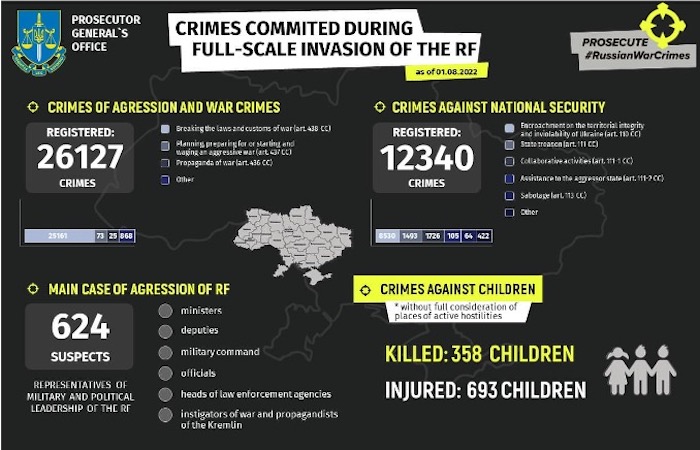
358 children were killed, and 693 children injured, the Office of the Prosecutor General of Ukraine reports
as of August 1. 2,199 educational establishments are damaged as a result of shelling and bombings, 225 of them are destroyed fully. 26,127 crimes of aggression and war crimes and 12,340 crimes against national security were registered.
Murder of Ukrainian POWs in Olenivka prison: everything we know
Support
Norway donates armored patrol vehicles to Ukraine, according to a press release from the Norwegian Government. “Norway has donated 14 IVECO LAV III armored patrol vehicles to Ukraine. These vehicles have good mobility and protection and are of the same type that Norwegian forces used in Afghanistan.”
Italy hands over another military aid package to Ukraine, Mil.In.Ua reports. “The exact content of the new military aid package is yet to be announced. At the same time, Italian media report that the package contains military vehicles, supplies, and equipment. The specific list of units is classified. In May, Italy handed over 155 mm FH70 towed howitzers to Ukraine.”
US Dept of Defense declares very effective use of military aid by Ukraine, KyivPost reports. The US Department of Defense announced the very effective use by Ukraine of weapons provided by Washington, as well as the preparation of the next package of military assistance.
“The Ukrainians have become very effective in finding and killing Russian command and control nodes and destroying swaths of Russian materiel, [a senior Defense Department official said]. “Even as Russia is talking the big talk, even as Russia is menacing the Ukrainian population, the Ukrainians continue to bravely advance. They’re making tremendous use of the $8.2 billion in equipment we’ve provided, thus far,” the official said.
It is noted that the [US Department of Defense] is closely consulting with the Ministry of Defense of Ukraine to ensure the supply of the necessary material, including ammunition. DOD is putting together another security assistance package that will address those needs, the official said.
The preparation of a new package of military assistance was announced by Minister of Defense of Ukraine Oleksiy Reznikov. We maintain a constant dialogue with the US Secretary of Defense Lloyd James Austin III. Today we discussed the latest developments since our last conversation. I’m glad that the US Secretary of Defense is back with good news. Means to strengthen our defence capabilities are coming soon, Reznikov said on Twitter Friday night.”
The Germans will open a service centre for Ukrainian self-propelled guns in Poland, UkraineToday reports, citing Spiegel. “The German government is negotiating with the defence industry to establish a repair centre in Poland that will be able to promptly service the transferred PzH 2000 self-propelled guns.
According to Spiegel, a month after the delivery of German artillery systems to Ukraine, self-propelled howitzers already show signs of wear. In the middle of the week, Kyiv informed the German Ministry of Defense that the control systems of some of the seven Panzerhaubitze 2000 delivered at the end of June displayed malfunction messages after intensive shelling of Russian positions. Therefore, several howitzers need repair.
The Bundeswehr believes that the problems are related to the high rate of fire with which the Ukrainian armed forces use guns in the fight against the Russian invaders; as a result, the howitzer loading mechanism is subjected to a huge load. The German military considers a norm of 100 shells per day to be high intensity, but the Ukrainians apparently fired much more. In addition, it is claimed that the Ukrainians tried to fire special ammunition at too great a distance. These so-called smart munitions are designed for particularly accurate and effective hits.
After the report from Ukraine, the Bundeswehr immediately agreed to quickly send additional packages of spare parts to Ukraine to solve the problems. In Bundeswehr circles, it was said that the signs of wear and tear were clear, as Ukraine would place great demands on the system in combat.”
New Developments
- On Day of the Navy, Putin says the United States is the main threat to Russia, Reuters “President Vladimir Putin on Sunday signed a new naval doctrine which cast the United States as Russia's main rival and set out Russia's global maritime ambitions for crucial areas such as the Arctic and in the Black Sea.”
- Russian occupation authorities claim Black Sea Fleet headquarters in Sevastopol struck, Ukrainska Pravda reports, citing RIA Novosti, a Russian Kremlin-aligned news outlet; Mihail Razvozhaev, Governor of Sevastopol, on Telegram. “The Russian-appointed Governor of Sevastopol – a city in Crimea which is occupied by Russia – has claimed that a drone struck the headquarters of the Russian Black Sea Fleet in Sevastopol. Celebrations planned for Russian Navy Day have been cancelled.”
- The Joint Coordination Centre (JCC) authorised the M/V Razoni to sail from the port of Odesa today, according to a press release by the Joint Coordination Centre, Black Sea Grain Initiative. “The JCC has agreed to the specific coordinates and restrictions of the Safe Humanitarian Maritime Corridor and has communicated those details in accordance with international navigation procedures. The JCC has requested all its participants to inform their respective military and other relevant authorities of this decision to ensure the safe passage of the vessel.
The JCC has also verified the capability of the vessel to depart and of the port readiness in Odesa prior to this authorization. The M/V Razoni will carry over 26,000 metric tonnes of corn. Once it leaves Odesa, it is estimated to arrive at the inspection location in Turkish territorial waters tomorrow, 2 August. Following inspection, it will proceed to its final destination in Tripoli, Lebanon. The JCC is monitoring the safe passage of the vessel through the Safe Humanitarian Maritime Corridor.”
Hans Petter Midttun: According to its AIS, the vessel was underway and about to depart Odesa Port at 07:40 GMT today.
https://twitter.com/EuromaidanPress/status/1553741377011343363
Assessment
- On the war.
The Institute for the Study of War has made the following assessment as of Sunday 31 July:
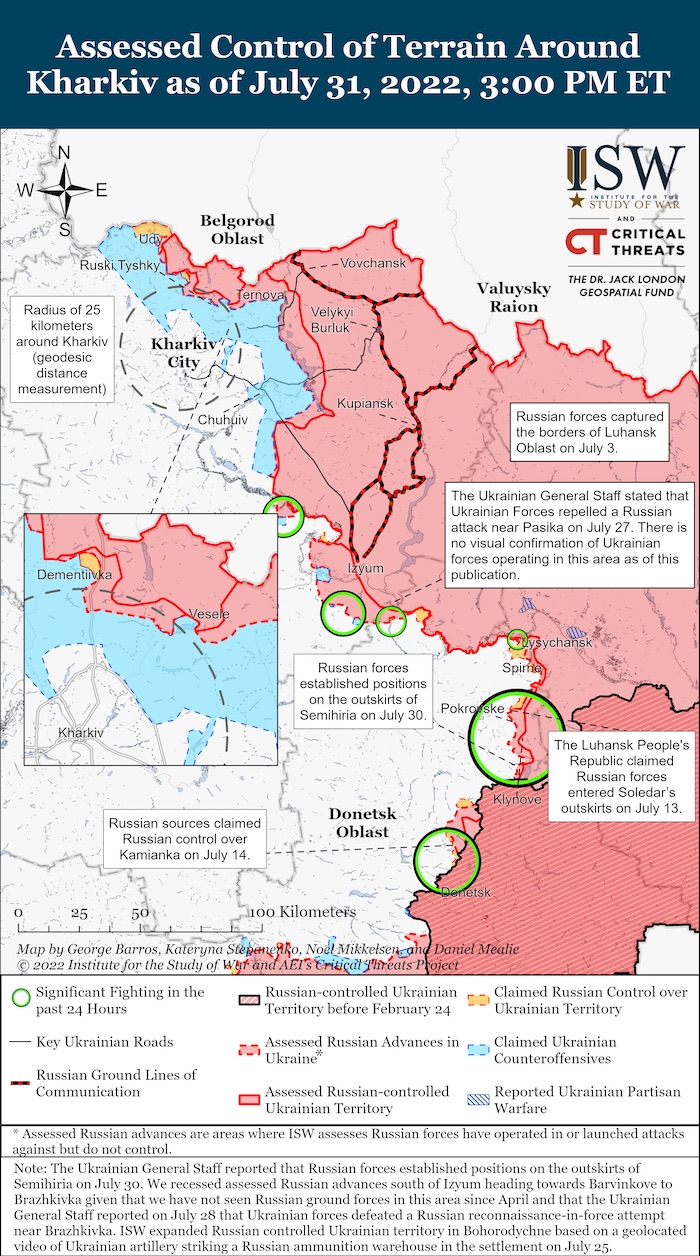
“Russian forces have resumed localized ground attacks northwest and southwest of Izium and may be setting conditions for offensive operations further west into Kharkiv Oblast or toward Kharkiv City. Russian forces have already launched unsuccessful assaults and reconnaissance-in-force attempts on Chepil, Shchurivka, and Husarivka (northwest of Izium) and resumed assaults on Dmytrivka and Brazhikivka (southwest of Izium) in recent days. Russian forces maintained positions around Balaklia and Velyka Komyshuvakha for months and may use these two areas as springboards for an offensive operation. Russian forces may use their positions around Balaklia to restart assaults on Kharkiv City from the southeast. Russian forces are extremely unlikely to seize Kharkiv Oblast or capture Kharkiv City – the second most populated city in Ukraine – given the pace of Russian progress in Donbas and continued challenges in force generation and logistics. ISW has previously assessed that Russian President Vladimir Putin may have ordered Russian forces to take Kharkiv City and the unoccupied portion of Kharkiv Oblast but that he is unlikely to be successful in such goals. Russian forces may also be conducting spoiling attacks to prevent Ukrainian counteroffensives.
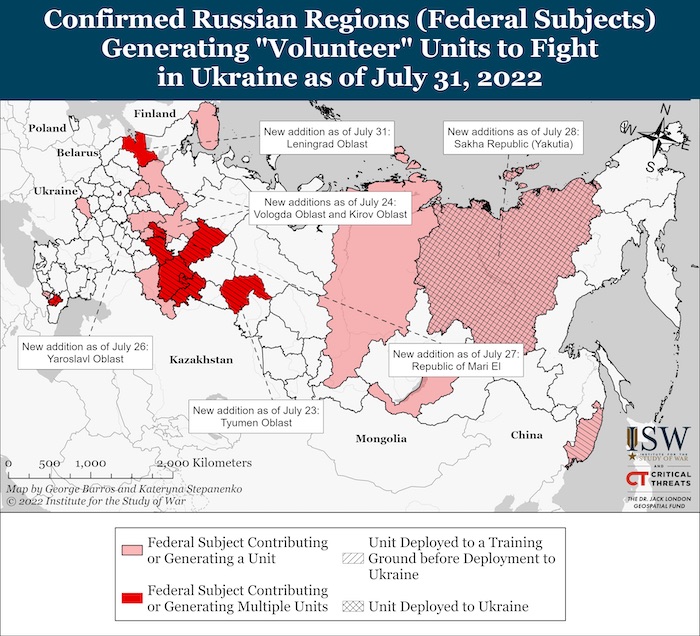
Crimean occupation officials obliquely accused Ukraine of orchestrating a drone attack on the Russian Black Sea Fleet headquarters in occupied Sevastopol on July 31, but Ukrainian officials denied responsibility for the attack. Russian Governor of Sevastopol Mihail Razvozhaev claimed that Ukrainians “decided to spoil” Russia’s Navy Day celebrations and noted that a drone exploded in the headquarters’ yard but did not specify whether Ukrainian forces or locals launched the drone. Razvozhaev published images showcasing minor damage to the headquarters building and yard, and social media footage depicted a small cloud of smoke rising from the building. Razvozhaev also claimed that the explosion wounded six people. Russian Crimean Senator Olga Kovitidi later announced that unspecified actors carried out the attack with a makeshift drone from within the territory of Sevastopol. The Ukrainian Naval Forces and Odesa Oblast Military Administration Spokesman Serhiy Bratchuk indirectly suggested that the drone attack was a Russian false flag operation. ISW cannot independently verify the actor responsible for the attack.
The Russian government may be complicating international efforts to discern the nature of an unidentified July 28 kinetic event on the Olenivka penal colony. The Russian Ministry of Defense officially invited experts from the United Nations and the International Committee of the Red Cross (ICRC) to investigate the attack at the Olenivka prison on July 30. The ICRC stated that it has not received access to the prison as of July 31, however. Ukrainian Deputy Prime Minister Iryna Vereschuk also noted that Russian authorities have not responded to Ukrainian requests to return the bodies of deceased Ukrainian prisoners of war (POWs).
Open-source intelligence (OSINT) analyst Oliver Alexander published an examination of satellite imagery from July 27 showing open graves at the Olenivka prison, noting that July 29 satellite imagery appears to show that the same graves have been covered. Investigative journalism group Bellingcat founder Eliot Higgins stated that lower resolution satellite imagery indicates ground disturbances after July 18 and prior to July 21, suggesting that the Russians may have planned the incident in advance. ISW will continue to monitor the open source for information on the strike on Olenivka and will provide updates as they appear.
Key Takeaways
- The Kremlin has not responded to the International Red Cross (ICRC) request to access the Olenivka prison as of July 31, hindering the international investigation efforts.
- Russian forces conducted limited ground attacks southwest and northwest of Izium, consistent with ISW’s assessment that Russian forces may be setting conditions for advances northwest of the current Izium-Sloviansk line.
- Russian forces continued ground attacks northwest of Sloviansk, northeast of Siversk, and to the east and south of Bakhmut.
- Russian forces made marginal gains in the Avdiivka area and continued ground attacks towards Avdiivka and Pisky.
- Russian authorities began recruiting volunteers for the Nevsky and Ladoga Battalions in Leningrad Oblast, Russia.
- Russian occupation authorities continued to prepare for a referendum in Kherson Oblast and took measures to depict support for Russian control of the occupied territories.“ (unquote)
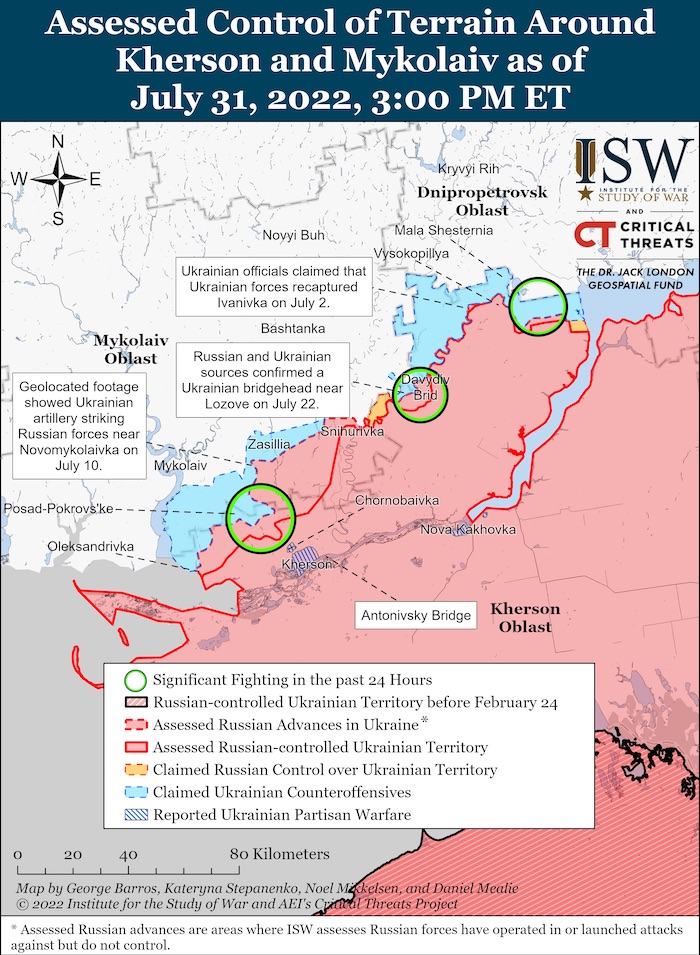
As Ukraine defends in the east and south, a US official says Russia’s war effort is failing, The New York Times reports. “Ukraine made small but steady gains in the southern region of Kherson, a port city in the south where thousands of Russian soldiers are now largely isolated after Ukrainian strikes on key supply routes. A senior US Defense Department official acknowledged those advances at a news briefing on Friday and said there was growing evidence that steep Russian losses had left some units ill-prepared to fight.
The official described Russia’s recent efforts as a failure both on the battlefield and at home, where Moscow’s rhetoric about its ambitions in Ukraine has grown more bombastic in recent days. Senior Kremlin officials have talked of regime change in Kyiv, and Prime Minister Dmitri Medvedev of Russia posted a map on his Telegram channel depicting a Ukraine swallowed up by Russia and its neighbors.
Although Russia’s forces are trying to push deeper into the Donetsk region of eastern Ukraine, they have not been able to break through Ukrainian defenses, according to Ukrainian and Western officials.
“Throughout July, the occupiers have been trying to storm Donetsk region,” Serhii Haidai, the head of the military administration in neighboring Luhansk Province, said in a statement. But unlike with the Russians’ push in the spring and early summer, when they could use their significant artillery advantage to flatten areas before advancing, Mr. Haidai said the Ukrainians’ destruction of Russian ammunition depots had “made it much more difficult for them to replenish arms stocks and maneuver.”
Using Nuclear Reactors for Cover, Russians Lob Rockets at Ukrainians, The New York Times reports. “Russia has turned Europe’s largest nuclear power plant into a fortress, stymying Ukraine’s forces and unnerving locals who fear both shelling and a radiation leak. Nikopol, controlled by the Ukrainians, lies on the west bank of the Dnipro River. On the opposite bank sits a gigantic nuclear power plant — Europe’s largest — that the Russian Army captured in March. The Russians have been firing from the cover of the Zaporizhzhia station since mid-July, Ukrainian military and civilian officials said, sending rockets over the river at Nikopol and other targets.
It is, in effect, a free shot. Ukraine cannot unleash volleys of shells in return using American-provided advanced rocket systems, which have silenced Russian guns elsewhere on the front line. Doing so would risk striking one of the six pressurized water reactors or highly radioactive waste in storage. And Russia knows it.
“They are hiding there so they cannot be hit,” said Oleksandr Sayuk, the mayor of Nikopol. “Why else would they be at the electrical station? To use such an object as a shield is very dangerous.” […]
The attacks from the nuclear plant are complicating Ukraine’s plans in the south, which has become the focal point of the war as Russian advances in the east have slowed.
The Ukrainian Army has for more than two months been telegraphing an intention to counterattack on the west bank of the Dnipro River, with the goal being to liberate the city of Kherson. Using a long-range American rocket-launching system known as HIMARS, Ukraine has been softening up Russian positions and cutting supply lines. This month rocket strikes destroyed a road and railroad bridges pivotal for Russian resupply of forces on the west bank, to the south of Nikopol, closer to Kherson.
As the counterattack picks up, the Zaporizhzhia nuclear plant poses a quandary. Russian forces have occupied the nuclear site since March 4 but began using it for artillery strikes only three weeks ago, Ukrainian officials say, about when HIMARS appeared on the battlefield. Shielded from return fire, the Russians are menacing Ukrainian troops advancing toward the Nova Kakhovka dam on the Dnipro River, one of the last remaining crossing points for Russian resupply.
It is a problem Ukraine will have to solve as it moves troops and equipment into the area for the counteroffensive.
The Ukrainian Army’s retaliatory options at Nikopol are limited. One tactic it has tried is to execute precision strikes that avoid, as much as possible, the risk of damaging the reactors. On July 22, for instance, Ukraine’s military intelligence agency reported a strike with a kamikaze drone that blew up an antiaircraft installation and a Grad rocket launcher and that killed soldiers in a tent camp about 150 yards from a reactor.
The fighting near the power plant has renewed worries that the war will set off a release of radiation in a country chockablock with delicate and dangerous nuclear sites, including Chernobyl, which Russia occupied in March but then abandoned.
When the Russian Army seized the Zaporizhzhia plant in March, combat ignited a fire — and a good deal of worry about nuclear safety. In that fighting, shrapnel hit but did not breach the containment structure of Reactor No. 1. Three of the six reactors are active now, and the others are idled or undergoing repairs.
Only a direct strike with a powerful weapon would penetrate the reactors’ yard-thick concrete containment vessels, said Dmytro Orlov, the exiled mayor of the city of Enerhodar, where the reactor is, and a former engineer at the plant. But if that happened, it would risk a meltdown or explosion that could spread radiation on the wind within Ukraine and beyond, as happened at Chernobyl in 1986, the world’s worst nuclear disaster.
Another risk is that a shell could hit the highly radioactive spent fuel stored in concrete canisters and spread radiation locally in the open air, like a dirty bomb.
The fatigue and stress of the Ukrainian control room employees at the reactor are also a concern. Russian soldiers have subjected them to harsh interrogations, including torture with electrical shocks, suspecting them of sabotage or of informing the Ukrainian military about activities at the plant, Mr. Orlov said. About a dozen have vanished after being abducted, he said.
The site is in a nuclear regulatory limbo. The Russian military controls the plant, but Ukrainian engineers operate it. The Russians allow Ukrainian truck convoys across the front line with spare parts and chemicals needed to process cooling water. Ukrainian nuclear regulators also cross the front to visit the plant. Rosatom, the Russian state nuclear company, has dispatched about a dozen engineers to monitor its operation. […]
2. Consequences and what to do?
Hans Petter Midttun: What is there to say that has not been said before? A protracted war is still protracted with no signs of a breakthrough as winter is approaching.
Ukraine, fighting for its right to exist and facing an existential threat, is not about to give up. On the contrary, Ukrainian professionalism, courage and resilience are little by little pushing Russian forces back. They are infecting massive losses on Russian forces.
Even though there is no path out of economic oblivion for Russia as long as the allied countries remain unified in maintaining and increasing sanctions pressure, and despite the obvious structural problems the Russian armed forces are facing – from manning and leadership problems to massive logistical challenges and technical problems – Russia shows no sign of wanting to end the war.
NATO is still not acting according to its past strategic concepts but has instead published a new concept committing to do less. Despite a war that threatens European security, stability and prosperity, despite years of Russian Hybrid War against the West, despite Russia declaring that we are involved in a broader conflict (including an information war, economic war, acts of aggression, war with Russia through a proxy and a total war), despite the Russian ultimatums of December 2021, and despite the “tsunami of ripple effects” from the war (e.g. costs of living, food and energy insecurity, famine, recession, inflation, and more) increasing the likelihood of global unrest, riots, and collapse of the governments – despite all of this, NATO has decided to limit its engagement to the political sphere, deciding to provide Ukraine with nonlethal support only. The Alliance has decided not to conduct a humanitarian intervention in Ukraine to end the war and alleviate the many devastating consequences of the war.
The West is still not providing Ukraine with the tools it needs to evict Russia from its territory. Ukraine is still unable to effectively defend its airspace or maritime exclusive economic zones. Its ability to conduct joint operations in support of its ground forces is still very limited. Ukraine continues to defend itself with one hand tied behind its back. It is even denied the opportunity to strike legal targets on the aggressor's territory. Nor does the West help break the maritime blockade that is undermining the economic viability of the state, threatening the future collapse of Ukraine.
Neither the USA nor Europe stands ready to protect international shipping if they start transporting grain from Ukraine to reduce the scope of the global famine resulting from the war. The ships that are about to depart Ukrainian ports – the first “grain convoy” – are ships that have been stuck in Ukrainian ports since the full-scale invasion started on 24 February. They are eager to leave. It is not given that they are equally eager to return.
The list of things we have not done – commitments and expectations we have not met – and consequences that have yet to materialize – is not complete.
I fear, however, that we are slowly running out of time. The full effect of the “tsunami of ripple effects” will hit us with winter, and winter is less than 4 months away. For many, the heating season starts in October already.



